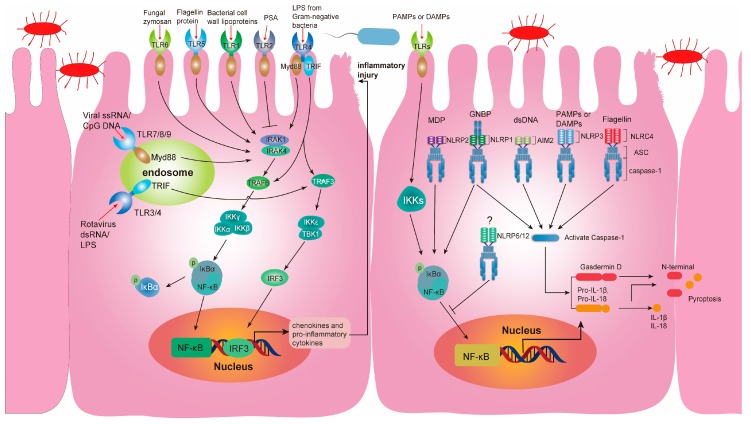Figure 3.
Diagram showing the activation pathways of toll-like receptors (TLRs) and NOD-like receptors (NLRs) in the intestinal epithelial cells. Intestinal epithelial cells (IECs) express multiple pattern recognition receptors (PRRs) including TLRs and NLRs, which can recognize pathogen-associated molecular patterns (PAMPs) and damage-associated molecular patterns (DAMPs). TLRs are present in cell membranes and endosomes. When TLRs sense PAMPs or DAMPs, they can recruit signaling adaptors (myeloid differentiation factor 88, MyD88) and then initiate a signaling cascade in MyD88 dependent mechanism, eventually causing the transcriptional activation of nuclear factor kappa-B (NF-κB). TLRs can also be activated in the MyD88 independent mechanism that involves TIR-domain-containing adaptor protein inducing interferon-β (TRIF). Canonical activation of NLR family pyrin domain-containing proteins (NLRPs) requires two signals. Signal 1 is activated by PAMPs or DAMPs through TLRs for the upregulation of pro-IL-18 and pro-IL-1β. Signal 2 involves the sensitization of NLRs and the assemble of inflammasome, which further induces the activation of caspase-1 to cleave pro-IL-18, pro-IL-1β, and Gasdermin D. Eventually, IL-18, IL-1β, and Gasdermin D N-terminal domain induce cell pyroptosis. TRAF: TNF receptor-associated factors; IRAK: IL-1R-associated kinases; IKK: inhibitor of NF-κB kinase; IκBα: inhibitor of NF-κBα; IRF: interferon-regulatory factors; TBK1: TANK-binding kinase 1; PSA: Polysaccharide A; ssRNA: single-stranded RNA; dsRNA: double-strand genomic RNA; CpG DNA: CpG-rich hypomethylated DNA motifs in microbial genome; GNBP: Gram-negative bacterial peptidoglycan; MDP: muramyl dipeptide.

